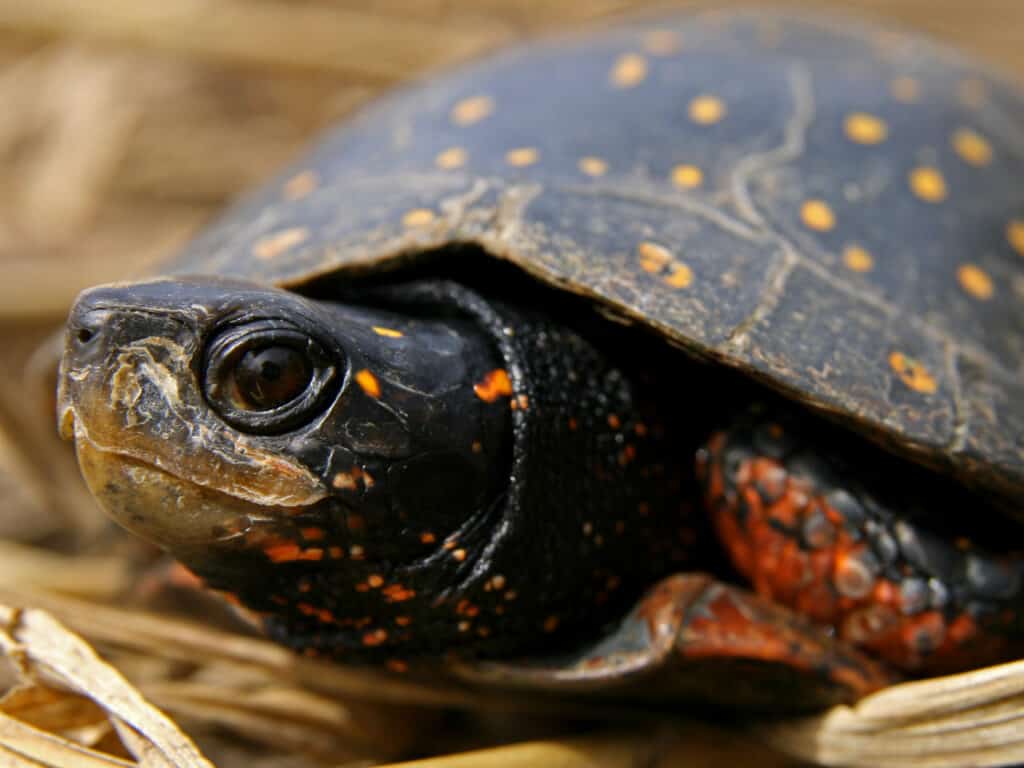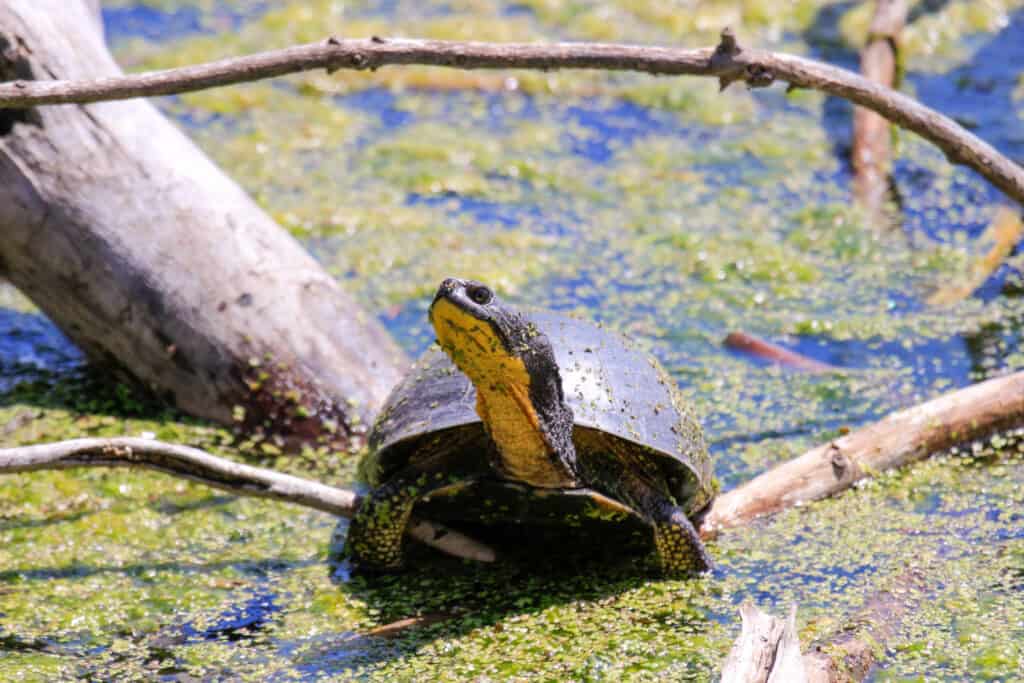At first glance, Maine seems like it’d be far too chilly and harsh for most turtle species to live and thrive. However, the aptly-named Pine Tree State is actually home to a handful of pretty diverse shelled reptiles. In fact, there are around ten or so different species in the state –from tiny pond sliders to giant snapping turtles! Below, we’ll take a closer look at five of Maine’s most amazing turtles you should definitely know about, whether you live there or just plan on visiting.
1. Spotted Turtle (Clemmys guttata)

The spotted turtle is undoubtedly one of the most stunning turtles in Mine with its colorful spots across its shell.
©Ryan M. Bolton/Shutterstock.com
The handsome semi-aquatic spotted turtle is certainly one of Maine’s most colorful and unique-looking reptiles! Both its dark grey carapace and skin are covered with tiny yellow spots, making it stand out despite its small size at just 2 to 4 inches long on average. The underside of its shell, the plastron, is also quite unique, ranging in color from pale yellow to bright orange with large brown splotches that grow and darken with age.
In Maine, the spotted turtle is currently classified as threatened primarily due to habitat loss. Though their numbers have been dwindling, they primarily live in slow-moving, shallow freshwater habitats like streams, ponds, bogs, marshes, and even drainage ditches along roadsides. Their geographic range covers most of the US east coast, stretching as far upwards as Maine’s southern border and even extending west into the Great Lakes area.
Interestingly, the exact number of spots on the spotted turtle’s shell vary significantly from individual to individual. Some turtles have just a few of these adorable polka dots on their shells, while others can have a hundred or more! What’s more, researchers have found the left sides of their shells tend to have more spots when compared to the right sides, though they aren’t sure why!
2. Blanding’s Turtle (Emydoidea blandingii)

The blandings turtle is considered endangered in Maine and it is rarely seen in the wild.
©iStock.com/mynewturtle
Named after American naturalist Dr. William Blanding, the Blanding’s turtle is another one of Maine’s more vibrant reptiles. While the top half of its body and tall, dome-shaped shell are mostly dark brown, the majority of its chin and throat are solid bright yellow! It’s much larger than the aforementioned spotted turtle, averaging 7 to 9 inches long.
Sadly, this stunning reptile is currently endangered in Maine. It also has a very shy and reclusive temperament. As a result, it’s very rare to see it in the wild up close in the Pine Tree State. Still, Blanding’s turtles live in small numbers along the state’s southern border in a variety of freshwater habitats. They are highly aquatic and prefer marshes, ponds, and swamps with dense vegetation and plenty of basking spots like rocks and logs. The species’ geographic range mainly covers the Great Lakes area. However, it also extends up into the US’ northeast coast and even into southern Canada.
Notably, the Blanding’s turtle is also very unique for its hinged plastron similar to that of the box turtle. However, the hinges on the bottom of its shell don’t close quite as tightly as a box turtle’s shell. This has resulted in it being dubbed a “semi-box turtle” by some herpetologists.
3. Wood Turtle (Glyptemys insculpta)

The wood turtle mainly inhabits slow-moving rivers and streams with sandy bottoms.
©Jay Ondreicka/Shutterstock.com
From a distance, the wood turtle looks rather unremarkable. As far as Maine’s turtles go, it’s average in size, ranging from about 5 to 8 inches long. Up close, however, the origins of its scientific name, insculpta, become very clear! Its rather flat, craggy, uneven dark brown carapace has lots of raised, pyramid-shaped scutes with many small lines and grooves. This gives it a distinctly sculpted and rugged appearance.
Though the wood turtle is somewhat uncommon in Maine, it thankfully isn’t threatened or endangered like some of the other species on this list. Its preferred habitats include slow-moving rivers and streams with soft, muddy or sandy bottoms that it can burrow into during the winter. Its geographic range covers virtually all of Maine and, by extension, most of the United States’ northeast coast, stretching from northern Virginia well up into southern Canada.
In addition to having a pretty funky-looking shell, the wood turtle is notable for being highly intelligent! In particular, it’s very skilled at tracking down prey compared to other turtle species. It can travel hundreds of feet to and from its home range daily without ever getting lost. Some studies have even compared its homing abilities to that of a common rat!
4. Eastern Musk Turtle (Sternotherus odoratus)

The eastern musk turtle is also known as the stinkpot turtle because it sprays a foul-smelling musk!
©iStock.com/AntonyMoran
Also lovingly known as the stinkpot turtle, the eastern musk turtle’s most prominent trait is not its appearance but rather its unique defense mechanism. Thanks to the scent glands along the edges of its shell, it is able to spray a foul-smelling musk to deter predators. Despite its small size at just 2 to 5 inches long, it packs quite the smelly punch! Thankfully, the turtle is easy to identify by the thin yellow stripes running down either side of its triangular, pointed snout.
This hardy, highly aquatic reptile has a wide geographic range and can thrive in various freshwater habitats. It lives throughout the eastern half of the United States and can be found as far north as southern Maine. It spends most of its time in shallow, slow-moving streams, creeks, and ponds with lots of aquatic vegetation.
Strangely, the eastern musk turtle actually isn’t a very strong swimmer–despite being highly aquatic. This handicap doesn’t slow it down, though, as it prefers to simply walk along the soft, muddy bottoms of its many habitats in search of prey like worms and snails. It can stay underwater for long periods of time with the help of lots of tiny bumps on its tongue that allow it to breathe while submerged.
If you happen to spot an eastern musk turtle in the wild, admire it from a distance and approach it with caution! If you manage to avoid its smelly musk, it may opt to just bite you with the help of its deceptively long neck for its size. Although this turtle is tiny, it’s surprisingly fierce.
5. Painted Turtle (Chrysemys picta)

There are three subspecies of painted turtles and two of them can be found in Maine.
©iStock.com/Wildpix645
We’ll cap off this list of terrific turtles with the painted turtle, a species made up of three total subspecies. These three subspecies (eastern, midland, and western) vary slightly in size, color, and markings, and two of them reside in Maine: the eastern and midland varieties. Though they look very similar, the midland subspecies has a dark brown, U-shaped shadow on the underside of its shell, which the eastern variety lacks.
Both of Maine’s painted turtles are similar in size. They each average around 5 to 7 inches long. However, the midland variety can reach up to 10 inches in length. Aside from the midland’s distinctive plastron shadow, both species have a glossy, dark greenish-brown carapace with orange or reddish markings along their edges. Their skin is similarly greenish-brown with large yellow splotches on either side of the head and thin yellow and orange stripes along the face and throat.
Maine’s two painted turtle subspecies also share a similar geographic range that covers much of the United States’ east coast from South Carolina all the way up through southern Canada. Their preferred habitats share a lot of overlap, too. Generally, they spend most of their time in shallow, slow-moving streams, creeks, marshes, and ponds with ample vegetation and soft, muddy bottoms. However, they can also tolerate brackish water.
Collectively, the painted turtle’s three subspecies make it one of North America’s most widespread and abundant turtle species! They’re incredibly hardy and can live more than 50 years in the wild.
Up Next:
- 10 Spiders in Maine
- Discover the Deadliest Animals in Maine
- 9 Snakes in Maine (With Identification Guides and Pictures)
The photo featured at the top of this post is © Ryan M. Bolton/Shutterstock.com
Sources
- Maine State, Available here: https://www.maine.gov/ifw/fish-wildlife/wildlife/species-information/reptiles-amphibians/painted-turtle.html
Thank you for reading! Have some feedback for us? Contact the AZ Animals editorial team.






